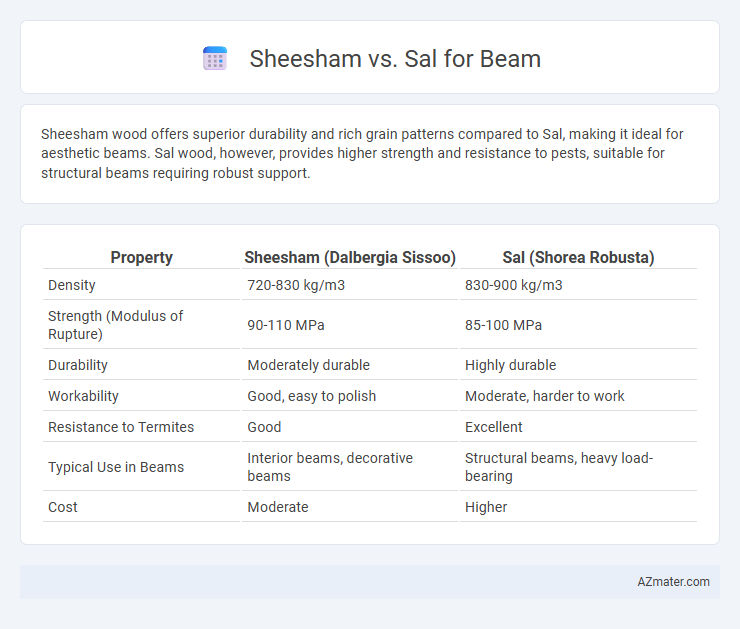Sheesham wood offers superior durability and rich grain patterns compared to Sal, making it ideal for aesthetic beams. Sal wood, however, provides higher strength and resistance to pests, suitable for structural beams requiring robust support.
Table of Comparison
| Property | Sheesham (Dalbergia Sissoo) | Sal (Shorea Robusta) |
|---|---|---|
| Density | 720-830 kg/m3 | 830-900 kg/m3 |
| Strength (Modulus of Rupture) | 90-110 MPa | 85-100 MPa |
| Durability | Moderately durable | Highly durable |
| Workability | Good, easy to polish | Moderate, harder to work |
| Resistance to Termites | Good | Excellent |
| Typical Use in Beams | Interior beams, decorative beams | Structural beams, heavy load-bearing |
| Cost | Moderate | Higher |
Introduction: Sheesham vs Sal for Beam Construction
Sheesham (Dalbergia sissoo) and Sal (Shorea robusta) are prominent hardwoods used in beam construction due to their strength and durability. Sheesham offers excellent resistance to decay and termites, making it ideal for indoor beams, while Sal is renowned for its superior hardness and weather resistance, suitable for outdoor structural elements. Choosing between Sheesham and Sal depends on the specific environmental conditions and load-bearing requirements of the construction project.
Overview of Sheesham Wood for Beams
Sheesham wood, also known as Indian Rosewood, is prized for its high density, durability, and resistance to warping, making it an excellent choice for structural beams. Its natural oils provide enhanced protection against decay and insect damage, extending the lifespan of beams in both indoor and outdoor applications. The rich grain patterns and deep hues also add aesthetic value, combining strength with visual appeal in construction projects.
Sal Wood Properties in Beam Applications
Sal wood is highly valued for beam applications due to its exceptional strength and durability, with a density ranging from 750 to 950 kg/m3, making it suitable for load-bearing structures. Its natural resistance to decay and termites enhances the longevity of beams used in construction, especially in outdoor or high-moisture environments. The coarse grain and straight texture of Sal wood provide excellent dimensional stability, reducing the risk of warping or cracking under sustained loads.
Strength and Durability Comparison
Sheesham wood offers excellent strength with a dense grain structure, making it highly durable and resistant to deformation under heavy loads, ideal for beam construction in structural applications. Sal wood, known for its superior hardness and toughness, provides exceptional durability and resistance to decay, often outperforming Sheesham in moisture-rich environments and heavy-duty use. Both woods are valuable for beams, but Sal's higher density and natural resistance to insects and fungi ensure longer-lasting performance in outdoor or high-stress conditions.
Resistance to Pests and Decay
Sheesham wood offers superior resistance to pests and decay due to its natural oils and dense grain structure, making it highly durable for beam construction. Sal wood, while strong and dense, is more susceptible to termite attacks and fungal decay without proper treatment. The inherent pest-resistant properties of Sheesham result in longer-lasting beams in humid and pest-prone environments.
Cost and Availability of Sheesham vs Sal
Sheesham wood is generally more expensive than Sal due to its rich grain and demand in furniture making, while Sal tends to be more affordable and widely available in many regions. Availability of Sheesham is somewhat limited as it is predominantly found in northern India, making procurement costlier outside this area; Sal, on the other hand, grows abundantly across central and eastern India, ensuring lower transportation costs and easier access. For beam construction, Sal offers a cost-effective solution with consistent supply, whereas Sheesham is preferred when aesthetics and durability justify the higher price.
Workability and Finishing Qualities
Sheesham wood offers excellent workability with fine grain and moderate hardness, making it easy to shape and finish beams with a smooth, polished surface. Sal wood is denser and harder, which can challenge cutting and carpentry but results in sturdy beams with durable, weather-resistant finishes. Both woods provide distinct finishing qualities: Sheesham shows rich, natural luster ideal for intricate designs, while Sal delivers a robust, rustic appearance suited for heavy structural use.
Sustainability and Environmental Impact
Sheesham (Dalbergia sissoo) is a fast-growing hardwood known for its durability and resistance to pests, making it a sustainable choice for beams due to its ability to regenerate quickly and lower carbon footprint. Sal (Shorea robusta) is a dense, long-lasting timber often harvested from slow-growing trees, which raises concerns about deforestation and habitat disruption in natural forests. Choosing Sheesham over Sal for beams supports better environmental impact through responsible sourcing and renewable forestry practices.
Popular Uses in Construction and Architecture
Sheesham wood, known for its rich grain and durability, is popular in furniture making, cabinetry, and decorative elements within construction due to its resistance to termites and attractive finish. Sal wood, characterized by its high density and hardness, is widely utilized in structural applications like beams, flooring, and heavy-duty frameworks because of its exceptional strength and weather resistance. Both woods are favored in architecture, with Sheesham preferred for aesthetic interior details and Sal chosen for robust exterior and load-bearing components.
Conclusion: Best Choice for Beams – Sheesham or Sal?
Sheesham wood offers greater durability and a richer grain, making it ideal for beams requiring both strength and aesthetic appeal. Sal wood is exceptionally dense and resistant to termites, suitable for heavy-duty structural applications in harsh environments. For optimal beam performance combining longevity, strength, and visual quality, Sheesham is generally the preferred choice, while Sal excels where maximum toughness and environmental resilience are critical.

Infographic: Sheesham vs Sal for Beam
 azmater.com
azmater.com